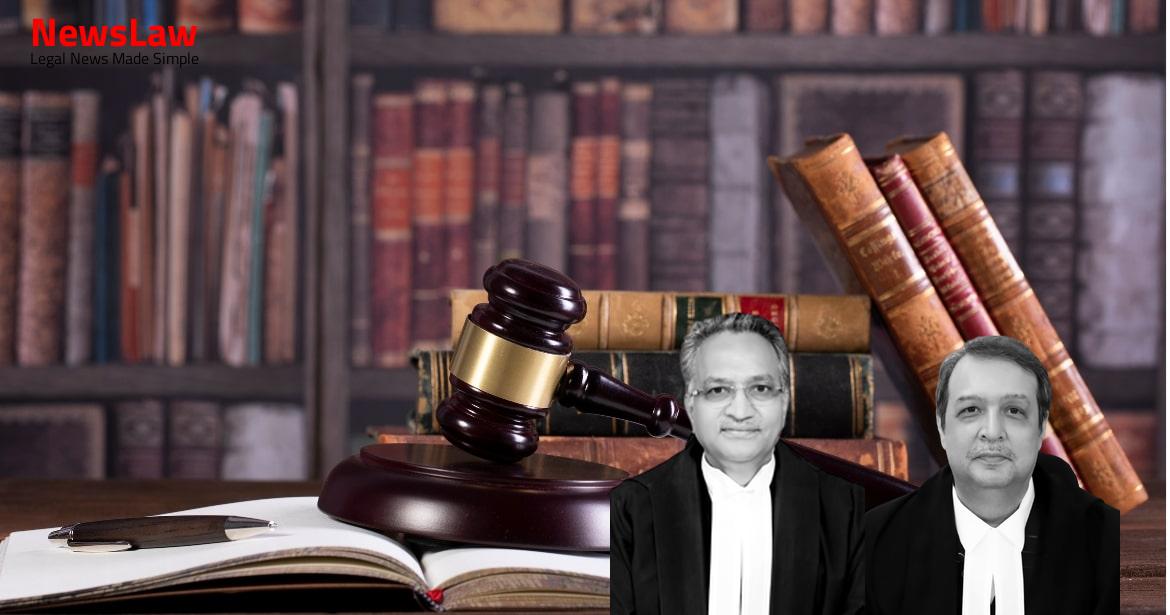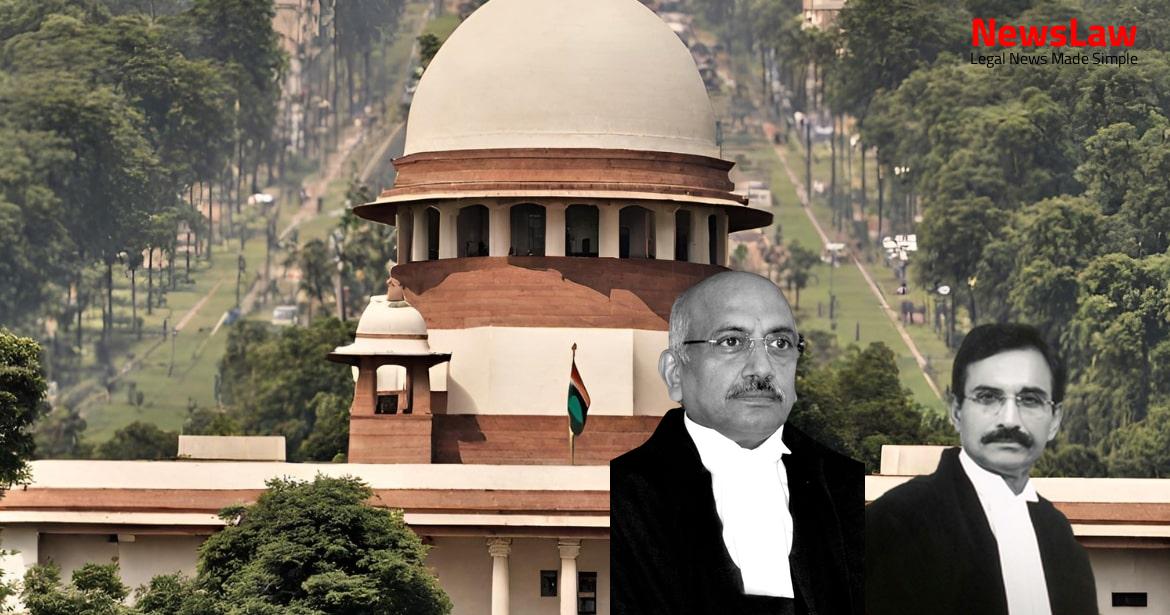Discover the in-depth legal analysis conducted by the court regarding discharge orders based on red ink entries in the military. The focus is on the court’s meticulous examination of procedural requirements, considerations of factors like service conditions and nature of violations, and the necessity of providing reasons for such significant decisions. Stay tuned for a breakdown of the court’s nuanced legal interpretation in this case.
Facts
- The appellant challenged the order of discharge before the Guwahati High Court through a writ petition
- The order of discharge was based on the appellant receiving four Red Ink entries during his service
- The order of discharge stated that the appellant’s conduct rendered his further retention in public service undesirable
- The appellant was given the opportunity to show cause against the proposed action but his replies were found unsatisfactory
- The Guwahati High Court, in a Writ Appeal, allowed the appeal filed by the Union of India & Ors., setting aside the earlier judgment in favor of the appellant
- The division bench of the Guwahati High Court allowed the writ appeal filed by the Union of India, setting aside the order of the single judge concerning the discharge of the appellant.
- A Division Bench decision in the Balwant Singh case was referenced, where it was established that the Commandant had the discretion to discharge a person with four or more Red Ink entries in the Assam Rifles.
- The Assam Rifles Act, 1941 and 2006 do not require the recording of reasons or satisfaction for a discharge decision.
- Based on the above interpretation of Clause 5 of ROI 1/2004, the court held that the orders of discharge could not be sustained.
- The court set aside and quashed the orders of discharge, remanding the matter to the respondents for a fresh decision in light of the Balwant Singh judgment and other considerations.
- It was suggested that the respondents may consider imposition of a lesser punishment on the petitioners after assessing their physical fitness, balancing the organization’s interests with those of the petitioners.
Issue
- The appellant joined the Assam Rifles as a Rifleman in 1993.
Arguments
- The learned Counsel for the appellant argued that discharge from service is not mandatory after four Red entries, and it is not automatic.
- The appellant was given notice and an opportunity to explain before the order of discharge was passed.
- The appellant’s reply to the show cause notice mainly cited family circumstances as a reason.
- The Assam Rifles Manual specifies the power of a Commandant to dismiss members below the rank of Jemadar.
- The learned Counsel emphasized that dismissal should be the last resort and not the first punishment option.
- The appellant emphasized that no error of law was committed by the High Court in the judgement and order.
- The learned Counsel presented reliance on specific court cases to support the appellant’s case for reinstatement with full back wages and benefits.
- The appellant was enrolled as an operator in the corps of Artillery of Indian Army on 27.09.1980.
- After nearly twelve years of service, he received a show cause notice citing four Red Ink entries for various offences.
- The notice accused Virendra Kumar Dubey of becoming a habitual offender, setting a bad example of indiscipline in the army.
Also Read: Supreme Court Judgment:
Supreme Court Upholds Benefit of Input Tax Credit in Uttar Pradesh Value Added Tax Act 2008
Analysis
- Rule 24 of the Assam Rifles gives power to Commandants to discharge subordinate officers/enlisted personnel with prior approval of higher authorities.
- The decision in Veerendra Kumar Dubey case highlights the need for an enquiry and consideration of defense before exercising power.
- The order passed on 26-2-2007 lacked consideration of relevant circumstances and guidelines from Army Headquarters.
- The Armed Forces Tribunal erred in rejecting the application due to procedural errors.
- Parameters under Army Instructions dated 28-12-1988 were considered to be satisfied in the case.
- Explanation for absence from duty on multiple occasions was not provided by the appellant, leading to punitive measures.
- The necessity of giving reasons for decisions by authorities was emphasized by the Supreme Court.
- Discharge on grounds of red ink entries should be weighed based on nature and severity of offenses committed.
- The authority must examine responses from individuals before making discharge decisions.
- Orders affecting rights of parties must clearly state how responses were considered before making a decision.
- Failure to consider relevant circumstances and lack of application of mind were observed in the case.
- Consideration of factors such as nature of violations, service conditions, and nearing pension eligibility is essential in discharge decisions.
- The case file must be forwarded for approval by the next superior authority after a discharge decision is made.
- Rules 24 and 25 of Assam Rifles Rules govern the procedure for dismissal/discharge of unsuitable subordinate officer/under officer/enrolled person
- A Show Cause Notice is to be served before taking any action against the individual
- An impartial enquiry must be conducted into the allegations against the individual before recommending discharge or dismissal
- The authority’s opinion is conclusive if certain conditions like following prescribed procedure, acting bona fide, forming its own opinion etc., are met
- Commandant of Assam Rifles Battalions is empowered to dismiss or remove any member below the rank of Nb/Sub
- An individual with four or more red ink entries may be recommended for discharge on the ground of unsuitability
- Warning is to be given after three red ink entries, stating that service may be terminated with one more red ink entry
- A person with eighteen years of qualifying service for pension may complete the required qualifying service before being recommended for discharge, unless there are compelling reasons for earlier discharge
- The court can inquire whether the facts and circumstances have a reasonable nexus with the purpose for which the power is to be exercised.
- The grounds considered for exercising the power must be relevant, and the order based on irrelevant grounds can be attacked as invalid and illegal.
- The court can interfere if the constitutional or statutory term essential for the exercise of the power has been misapplied or misinterpreted.
- Interference is permissible when the power is exercised for an improper purpose.
- If the power granted for one purpose is exercised for a different purpose, it will be deemed invalid.
- Administrative action can be invalidated if the authority was satisfied on the wrong question or based on irrelevant matter.
- The existence of circumstances is a condition precedent to forming an opinion by the Government.
- The Court can interfere if an inference from facts does not logically accord with them.
- If the power is not genuinely exercised for the intended purpose, but to avoid embarrassment or for personal vengeance, it will be deemed improper.
- Judicial review is permissible if there are no reasonable grounds for the formation of the authority’s opinion.
- Action based on an opinion formed without any evidence can be quashed by the courts, as it constitutes an abuse of power.
- The authority competent to sanction the discharge may seek the advice of the Law Officer before passing the discharge order.
- The order of discharge must be passed by an officer not less than a Sector Commander for Under Officers and other enrolled persons, and not less than Inspector General Assam Rifles/Additional Director General Assam Rifles for Subordinate Officers.
- In this particular case, the order of discharge was set aside and the appellant is considered to have been in service until completion of qualifying service for pension, to meet the ends of justice.
- The nature of misconduct leading to the Red Ink entries was not so unacceptable that discharge was the only option to prevent indiscipline in the force.
- Substantial justice is to be done in such cases where the misconduct does not warrant immediate discharge.
Decision
- The appellant shall be treated as in service until he would have completed the qualifying service for pension.
- No back wages will be provided.
- Continuity of service benefits, including pension, will be granted to the appellant.
- The discharge order against the appellant is set aside.
- Monetary benefits should be released within four months from the date of this order.
- No costs are awarded.
- The individual should be given minimum fifteen days to submit a reply after receiving the Show Cause Notice.
- Writ petitions are allowed to the extent mentioned.
- The appeals are allowed on the terms stated.
Case Title: AMARENDRA KUMAR PANDEY Vs. UNION OF INDIA (2022 INSC 724)
Case Number: C.A. No.-011473-011474 / 2018



